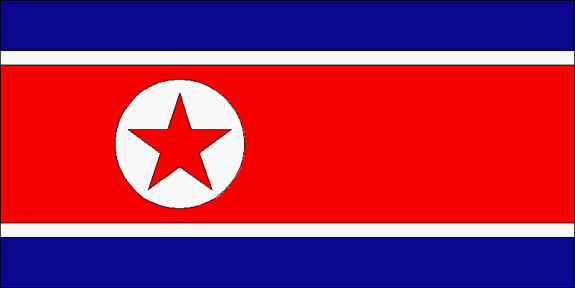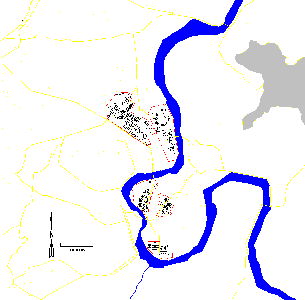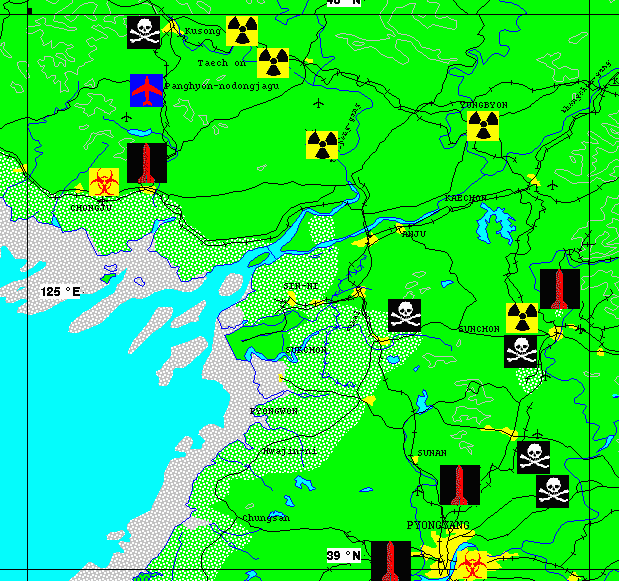





 North Korea has several nuclear facilities that, collectively, have
the potential to produce nuclear fuel for weapons. Most are located
at Yongbyon, 60 miles north of Pyongyang, which has an estimate staff of some 2,000. The major installations
include a 5-megawatt electric (MW(e)) research reactor, a
larger a 50-MW(e) reactor that was under construction in
Yongbyon, and a plutonium reprocessing facility. Yongbyon is also the site of the Radiochemical Laboratory of the Institute of Radiochemistry, the Nuclear Fuel Rod Fabrication Plant , and a storage facility for fuel rods.
North Korea has several nuclear facilities that, collectively, have
the potential to produce nuclear fuel for weapons. Most are located
at Yongbyon, 60 miles north of Pyongyang, which has an estimate staff of some 2,000. The major installations
include a 5-megawatt electric (MW(e)) research reactor, a
larger a 50-MW(e) reactor that was under construction in
Yongbyon, and a plutonium reprocessing facility. Yongbyon is also the site of the Radiochemical Laboratory of the Institute of Radiochemistry, the Nuclear Fuel Rod Fabrication Plant , and a storage facility for fuel rods.
Since nuclear development began in earnest in the '80s, the college of physics and technical college of physics were set up at Yongbyon to train specialists necessary for the operation of nuclear facilities like the 5MW atomic reactor in Yungbyun nuclear fuel re-processing plant and nuclear fuel manufacturing plant.
The 5 megawatt (MW) reactor, which the DPRK began constructing in 1980, uses natural uranium for fuel--which is readily available in North Korea--and is believed to have become operational in 1986. The 5-MW(e) research reactor is thought to be capable of producing about 7 kilograms of plutonium annually. North Korea operated the reactor for approximately seven years. This plutonium production reactor became operational in 1986 [and certainly by October 1987], with some refueling in 1989, thereby providing weapons-grade plutonium for at least one nuclear weapon. North Korea shut down its 5-MW(e) reactor for between 70 to 100 days in 1989. Some sources believe that North Korea removed and later reprocessed the fuel, separating up to 13 kilograms of weapons-grade plutonium usable for producing nuclear bombs. The suspected diversion was, among other things, inferred from a subsequent laboratory analysis of materials collected during IAEA's inspections that began in 1992. North Korea ran the 5-MW(e) reactor at low levels for about 30 days in 1990 and about 50 days in 1991. Such low levels of operation create the technical possibility that fuel could have been removed and subsequently reprocessed. However, US experts consider this unlikely. Fuel from this reactor also was discharged in May-June 1994 and, had it been reprocessed, could have provided enough plutonium for several additional nuclear weapons. North Korea was supposed to have produced 0.9 gram of Plutonium per megawatt every day over a 4-year period from 1987 to 1991. The 0.9 gram per day multiplied by 365 days by 4 years and by 30 megawatts equals to 39 kilograms. When the yearly operation ratio is presumed to be 60 percent, the actual amount was estimated at 60% of 39 kilograms, or some 23.4 kilograms.Estimates vary of both the amount of plutonium in North Korea's possession and number of nuclear weapons that could be manufactured from the material. South Korean, Japanese, and Russian intelligence estimates of the amount of plutonium separated, for example, are reported to be higher -- 7 to 22 kilograms, 16 to 24 kilograms, and 20 kilograms, respectively -- than the reported US estimate of about 12 kilograms. At least two of the estimates are said to be based on the assumption that North Korea removed fuel rods from the 5-MW(e) reactor and subsequently reprocessed the fuel during slowdowns in the reactor's operations in 1990 and 1991. The variations in the estimates about the number of weapons that could be produced from the material depend on a variety of factors, including assumptions about North Korea's reprocessing capabilities -- advanced technology yields more material -- and the amount of plutonium it takes to make a nuclear weapon. Until January 1994, the Department of Energy (DOE) estimated that 8 kilograms would be needed to make a small nuclear weapon. Thus, the United States' estimate of 12 kilograms could result in one to two bombs. In January 1994, however, DOE reduced the estimate of the amount of plutonium needed to 4 kilograms--enough to make up to three bombs if the US estimate is used and up to six bombs if the other estimates are used.
The 50-megawatt (electric) reactor would have produced enough plutonium for North Korea to build an additional 7-10 nuclear weapons per year. This reactor was expected to be completed in 1995. Because of this schedule, all of the reactor's equipment and components, including the reactor's graphite blocks and fuel-handling machines, should have been available for inclusion in the reactor's building. Instead, North Korea eventually informed IAEA that it had manufactured only about 50 percent of the graphite blocks needed for the 50-MW(e) reactor and none of the graphite blocks needed for the 200-MW(e) reactor at Taechon. According to IAEA, North Korea explained that there was no reason for it to continue manufacturing equipment and components for the two reactors after July 1993, since it had begun discussions with the United States about replacing the graphite-moderated reactors with light-water reactors. However, North Korea's explanation is insufficient for IAEA to rule out whether any additional nuclear equipment and components exist.
The two higher power reactors under construction at Yongbon and Taechon were expected to yield another 200 kilograms of plutonium annually -- enough plutonium for about 50 atomic bombs per year. The reactor facilities reportedly were not attached to a power grid, increasing concern that the facilities were intended to produce material for making nuclear weapons rather than for producing electricity.
The reprocessing facility separates weapons-grade plutonium-239 from the reactor's spent fuel. This large facility was key because it would have enabled Pyongyang to extract weapons-grade plutonium from irradiated fuel from both the 5- and 50-megawatt (electric) reactors.A probable nuclear waste storage facility (nicknamed 'Building-500') was built in 1976 in close proximity to the radiochemistry lab as a waste liquid storage tank, connected to the test lab with steel pipes on the ground. With the IAEA inspection just around the corner, North Korea covered the connecting steel pipes with dirt in October, 1991, encased the waste liquid storage building with a concrete wall, transplanted trees in the areas to camouflage it, and then built a storage building above the storage tank. However, the whole process was photographed by US imagery intelligence satellites.
Comprehensive safeguards agreement with DPRK entered into force on 10 April 1992, permitting verification that all nuclear material and all nuclear facilities in the DPRK were used exclusively for peaceful purposes and assessment of whether the initial declaration of material and facilities was complete and correct.On 04 May 1992 North Korea submitted its declaration of nuclear materials to IAEA, as required by IAEA's safeguards agreements. According to the declaration, North Korea had seven sites and about 90 grams of plutonium in its possession that were subject to IAEA's inspections. According to North Korea, the nuclear material resulted from its reprocessing of 89 defective fuel rods in 1989.
In July 1992 an IAEA inspection team collected information that subsequently resulted in the disclosure of discrepancies in North Korea's declaration of nuclear materials. Instead of reprocessing spent fuel from 89 damaged fuel rods on just one occasion, IAEA concluded that North Korea has probably reprocessed spent fuel on three to four occasions since 1989. Additional inspections revealed further inconsistencies in North Korea's declaration.
These inconsistencies between the DPRK's declaration of nuclear material and International Atomic Energy Agency [IAEA] findings led the Agency to conclude that undeclared plutonium must exist in the DPRK - whether in grams or kilograms. Three separate but possibly interrelated elements were the object of the Agency's special interest: firstly, two sites that were apparently related to nuclear waste that could provide evidence of reprocessing activities in the DPRK; secondly, the core of the 5 MW(e) Experimental Nuclear Power Reactor, the history of which could shed light on the extent of any possible reprocessing; and thirdly the DPRK's reprocessing plant - called the Radiochemical Laboratory - and the use that had been made of it.Late in 1992 the IAEA informally requested that it be given access to two additional sites -- located in the Yongbyon nuclear complex -- that it suspected of housing nuclear waste. North Korea allowed IAEA to visually inspect one of the sites but denied any access to the other. On 09 February 1993 IAEA invoked the "special inspections clause" of its safeguards agreement with North Korea, indicating that it wanted to inspect two sites that North Korea had not declared and that IAEA suspected had a bearing on the history of North Korea's nuclear program. North Korea denied IAEA access to the two undeclared sites. North Korea said that the sites were military installations with no connection to its nuclear program.
At a 22 February 1993 meeting of the IAEA board, the members were shown US overhead surveillance photographs and a chemical analysis of data collected by IAEA inspectors. The evidence reportedly confirmed the existence of a nuclear waste dump -- long denied by North Korea -- and disclosed discrepancies in North Korea's declaration of the nuclear materials in its possession. On 12 March 1993 North Korea announced its intention to withdraw from the NPT, effective June 12, 1993. The announcement elevated what was viewed as a serious proliferation threat into a major diplomatic confrontation between the United States and North Korea.
On February 15 1994, after lengthy talks with the IAEA, a detailed understanding was reached with the IAEA about conducting inspections that the Agency requested - with the exception of the two non-declared, apparently waste related sites. IAEA resumed inspections March 3-14, 1994. The inspectors proceeded without incident at several locations but encountered problems at the reprocessing plant, where they were precluded from entering certain portions of the plant and performing activities -- such as taking samples from reprocessing equipment and conducting a gamma ray scan of the reprocessing facility--that North Korea had agreed to on February 15, 1994. On 15 March 1994 IAEA terminated inspections after North Korea barred the inspectors from taking samples at key locations in its plutonium reprocessing plant. The March 1994 inspection reportedly indicated that North Korea had resumed construction on the second reprocessing line in the facility, constructed new connections between the old and new reprocessing lines, and broken seals on previously tagged reprocessing equipment.After further talks between DPRK and other States, the DPRK accepted Agency inspection of the points earlier blocked.
At about the same time, the DPRK informed the IAEA that it intended to refuel the 5 MW Experimental Nuclear Power Reactor, loaded in 1986 and operated since 1987. The IAEA wished during such refuelling to select a number of fuel rods, segregate them from the others, secure them so that they would not be replace by others and examine them. This was requested because an examination of the rods might show how long they had been in the reactor. If it were found that some or all the rods in the reactor had been there for a shorter time than eight years, that there could exist non-declared nuclear material, spent fuel, or perhaps plutonium and waste.
In Mid-May 1994 workers began removing the spent fuel from the 5-MW(e) reactor in violation of North Korea's safeguards agreement with IAEA and IAEA's previous instructions informing North Korea that IAEA inspectors would need to sample, segregate, and monitor the fuel rods to preserve evidence of past plutonium production. North Korea refused to comply but allowed two inspectors to watch the fuel-removal process. IAEA informed North Korea that the removal of fuel without proper safeguards constituted "a serious violation" of the safeguards agreement.
The United States offered to hold the long-deferred third series of high-level talks to consider the entire range of issues related to the Korean peninsula, including the economic, diplomatic, and other benefits that North Korea could receive in return for reversing its decision to withdraw from the NPT. The talks were conditioned on North Korea's willingness to allow IAEA to monitor the refueling operation and to safeguard the fuel rods already removed.
On 03 June 1994 IAEA's Director General told the United Nations Security Council that North Korea had removed all but 1,800 of the 8,000 fuel rods in the 5-MW(e) reactor and that by mixing them up, North Korea had made it impossible to reconstruct the operating history of the reactor.
Following progress made during bilateral consultations between DPRK and United States representatives, the DPRK accepted enlarging the scope of inspections in early September 1994. The IAEA inspectors were given access to the Nuclear Fuel Rod Fabrication Plant and the Nuclear Fuel Rod Storage facility for periodic inspections, as required by the IAEA. The inspectors were also enabled, in addition to the other activities being carried out at the 5 MWe Reactor, to enter the reactor fuel storage to verify the fresh fuel rod inventory. However, at the Radiochemical Laboratory, the DPRK continued to refuse to allow the Agency inspectors to ascertain the state of completion of the new process line under construction there and declined examination of records and gamma-mapping activities.On 21 October 1994, the United States and North Korea signed in Geneva a Framework Agreement to resolve the North Korean nuclear issue. Its main provisions were that the North would freeze and eventually dismantle its existing suspect nuclear program, including the 50 MW and 200 MW graphite-moderated reactors under construction, as well as its existing 5 MW reactor and nuclear fuel reprocessing facility. In return, Pyongyang would be provided with two 1,000 MW light-water nuclear reactors, which would be safer and would produce much less plutonium (the key material for atomic weapons), in order to help boost the supply of electricity in the North
Under the "Agreed Framework" the DPRK agreed that there would be no operations at the facilities covered by the freeze and no construction work of any kind, either at existing facilities or new, related facilities; that the spent fuel from the 5 MWe reactor will be stored and disposed of in a manner that does not involve reprocessing in the DPRK; and that any movements of nuclear material or equipment within those facilities, any necessary maintenance work by the operator and any transfers of nuclear material out of the facilities would have to be carried out under the observation of IAEA inspectors or under other IAEA arrangements.
IAEA inspectors regularly monitor the 5-MW(e) reactor, the fuel fabrication plant, and the reprocessing plant. IAEA uses all technical means available to monitor the freeze at these facilities, such as using seals that can indicate instances of tampering, using video cameras, and making short-notice inspections. The particular method(s) used depends on the circumstances at each of the three facilities. The primary monitoring method is the use and frequent verification of tamper-indicating seals on equipment and installations throughout the "frozen" nuclear facilities. Video cameras are also used for surveillance. Finally, short-notice inspections are used to monitor certain equipment and areas in the frozen facilities that have not been allowed to be sealed. IAEA inspectors also monitor activities related to the canning and storage of spent fuel from the 5-MW(e) reactor and have, through qualitative measurements of the fuel rods (spent fuel), verified whether the rods are, in fact, irradiated (spent) fuel rods.
As of late 1999 United States experts remained on-site in North Korea working to complete clean-up operations after largely finishing the canning of spent fuel from the North's 5-megawatt nuclear reactor.
The DPRK continues to maintain a freeze on its nuclear facilities consistent with the 1994 U.S.-DPRK Agreed Framework. North Korea has not allowed the IAEA to perform inspections sufficiently comprehensive at all sites to verify the operating history of the 5-megawatt (electric) reactor, the amount of reprocessing accomplished, and whether special nuclear materials have been diverted to develop nuclear weapons.
Under strict adherence to the Agreed Framework, North Korea must make its nuclear program completely transparent and must allow the IAEA to perform special inspections prior to the delivery of Nuclear Suppliers' Group (NSG) controlled items to the Light Water Reactors. North Korea also has obligated itself beyond its NPT and IAEA requirements by agreeing to eliminate eventually all its existing or planned nuclear power and related facilities.


